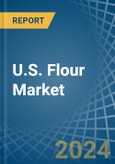Wheat flour (excluding flour mixes), made in flour mills; Wheat mill products, excluding flour; Corn mill products; Prepared flour mixes, including refrigerated and frozen doughs and batters, made in flour mills; Other grain mill products; Flour milling, nsk, total;
The report provides on a detailed analysis of the U.S. flour market. It reveals the latest data of the market size and volume, domestic production, exports and imports, price dynamics and turnover in the industry. In addition, the report contains insightful information about the industry, including industry life cycle, business locations, productivity, employment and many other crucial aspects. The Company Profiles section contains current data on the major players in the industry.
Countries coverage: the U.S.
Companies mentioned:
- Grain Millers
- The Pillsbury Company
- C. H. Guenther & Son
- Shawnee Milling Company
- Bay State Milling Company
- Bob's Red Mill Natural Foods
- Siemer Milling Company
- Blendex Company
- Chelsea Milling Company
- Star of The West Milling Company
- Post Foods, Hodgson Mill
- Italgrani U.S.A.
- Giusto's Specialty Foods
- The Mennel Milling Company
- Minsa Corporation
- Grain Craft
- J. R. Short Milling Company
- Guttenplan's Frozen Dough
- King Milling Company
- The Mennel Milling Co of Michigan
- Ardent Mills
- Spartan Foods of America
- Knoxville Milling Company
- The Morrison Milling Company
- Pasteleria Cidrines
- Sunopta Grains and Foods
- Crestar Crusts
- Riviana International
- H. Nagel & Son Co
Data coverage:
- Flour market size;
- Flour production, value of shipments;
- Key market players and their profiles;
- Exports, imports and trade balance;
- Import and export prices;
- Forecast of the market dynamics in the medium term;
- Key industry statistics;
- Life cycle of the flour industry;
- Number of establishments and their locations;
- Employment data;
- Flour industry productivity.
Reasons to buy this report:
- Take advantage of the latest data;
- Find deeper insights into current market developments;
- Discover vital success factors affecting the market.
This report is designed for manufacturers, distributors, importers, and wholesalers, as well as for investors, consultants and advisors.
In this report, you can find information that helps you to make informed decisions on the following issues:
1. How to diversify your business and benefit from new market opportunities
2. How to load your idle production capacity
3. How to boost your sales on overseas markets
4. How to increase your profit margins
5. How to make your supply chain more sustainable
6. How to reduce your production and supply chain costs
7. How to outsource production to other countries
8. How to prepare your business for global expansion
While doing this research, we combine the accumulated expertise of our analysts and the capabilities of artificial intelligence. The AI-based platform, developed by our data scientists, constitutes the key working tool for business analysts, empowering them to discover deep insights and ideas from the marketing data.
Table of Contents
Companies Mentioned (Partial List)
A selection of companies mentioned in this report includes, but is not limited to:
- Grain Millers
- The Pillsbury Company
- C. H. Guenther & Son
- Shawnee Milling Company
- Bay State Milling Company
- Bob's Red Mill Natural Foods
- Siemer Milling Company
- Blendex Company
- Chelsea Milling Company
- Star of The West Milling Company
- Post Foods, Hodgson Mill
- Italgrani U.S.A.
- Giusto's Specialty Foods
- The Mennel Milling Company
- Minsa Corporation
- Grain Craft
- J. R. Short Milling Company
- Guttenplan's Frozen Dough
- King Milling Company
- The Mennel Milling Co of Michigan
- Ardent Mills
- Spartan Foods of America
- Knoxville Milling Company
- The Morrison Milling Company
- Pasteleria Cidrines
- Sunopta Grains and Foods
- Crestar Crusts
- Riviana International
- H. Nagel & Son Co








